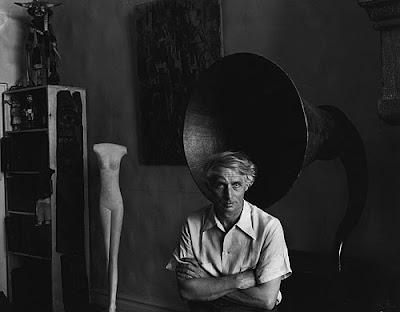 When people ask me about some of my favorite artist inspirations, I always bring up MAX ERNST, and I'm often surprised how little is known of him compared to other painters of his caliber like Dali or Magritte, who actually took inspirations from Ernst's early work[1]. Aside from his work, which first drew me in with its dreamy, otherwordly quality, I always felt a deep affinity for Max Ernst the artist, who stood out for me with his contemplative, spiritual approach to doing art.
When people ask me about some of my favorite artist inspirations, I always bring up MAX ERNST, and I'm often surprised how little is known of him compared to other painters of his caliber like Dali or Magritte, who actually took inspirations from Ernst's early work[1]. Aside from his work, which first drew me in with its dreamy, otherwordly quality, I always felt a deep affinity for Max Ernst the artist, who stood out for me with his contemplative, spiritual approach to doing art.Max ERNST (b. 1891 in Bruehl, Germany) was one of the most important painters of the 20th century, a founding figure of Dada and Surrealism- two of the most outspokenly anti-war art movements born and evolved as a reaction to the horrors of WWI and WWII. "As a child Max was strange and suffered many emotional crises and a few mental collapses. During the First World War, Max Ernst was conscripted into the Germany army to serve as an artillery engineer. The traumatic experience prompted Ernst to write in his autobiography, “Max Ernst died the 1st of August, 1914.” Ernst further emphasized his point by writing, “You cannot save a man who has already been dead. And I had been dead since the first ‘World War."[2] In 1937 Nazi officials purged German museums of art works the Party considered to be degenerate. From the thousands of works removed, 650 were for a special exhibit of Entartete Kunst-among them Max's works.
 In each installation, the works were poorly hung and surrounded by graffiti and hand written labels mocking the artists and their creations. Over three million visitors attended making it the first "blockbuster" exhibition."[3] Max fled from Nazi Germany to France, but with the outbreak of the Second World War Max Ernst was arrested by French authorities for being a "hostile alien". Thanks to the intercession of fellow artist, Eluard, he was discharged a few weeks later. Soon after the French occupation by the Nazis, he was arrested again, this time by the Gestapo, but he managed to escape and flee to the US in 1941.
In each installation, the works were poorly hung and surrounded by graffiti and hand written labels mocking the artists and their creations. Over three million visitors attended making it the first "blockbuster" exhibition."[3] Max fled from Nazi Germany to France, but with the outbreak of the Second World War Max Ernst was arrested by French authorities for being a "hostile alien". Thanks to the intercession of fellow artist, Eluard, he was discharged a few weeks later. Soon after the French occupation by the Nazis, he was arrested again, this time by the Gestapo, but he managed to escape and flee to the US in 1941. "Max developed a fascination with birds that was prevalent in his work. His alter ego in paintings, which he called Loplop, was a bird. He suggested this alter-ego was an extension of himself stemming from an early confusion of birds and humans. He said that one night when he was young he woke up and found that his beloved bird had died, and a few minutes later his father announced that his sister was born."[source WP]
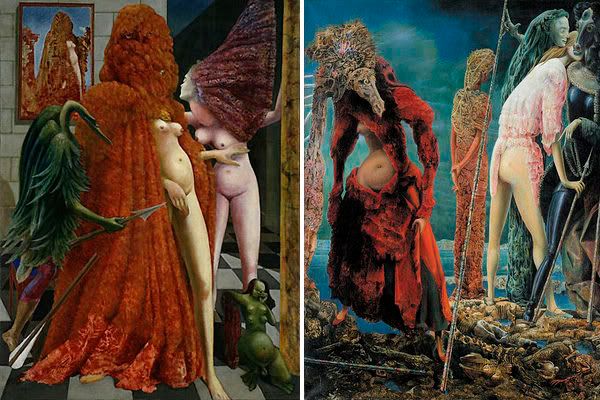
"When strolling through the forest, fixing the eyes obstinately on the ground, you certainly discover many wonderful, splendid things. If then, all of a sudden, you turn your eyes upwards, you are overwhelmed by the revelation of another equally wonderful world. The significance of suns, moons, constellations, nebulae, galaxies and space as a whole outside the earth zone have steadily taken root during the last century in human consciousness as well is in my work, and will most probably remain there." M. Ernst (Peter Shamoni, MAX ERNST Maximiliana, p. 5)
Of This Men Shall Know Nothing. Oil on canvas. 81 x 64 cm. 1923. Tate Gallery, London, UK.
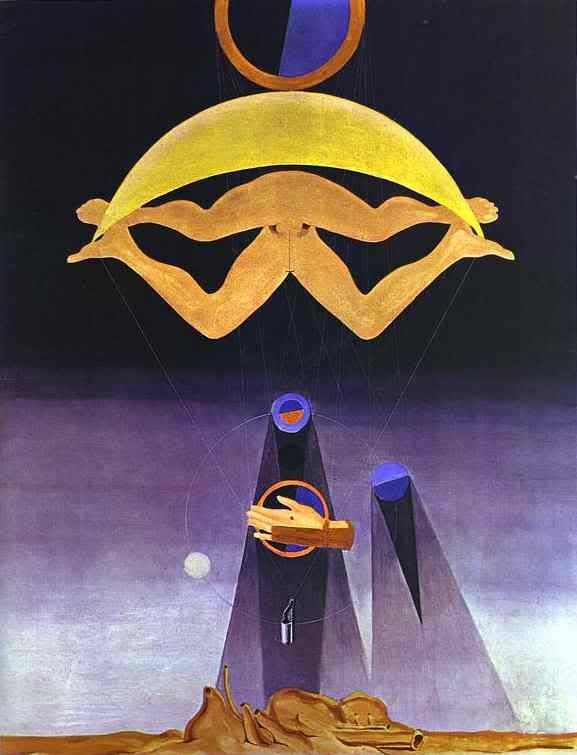
The Equivocal Woman (also known as The Teetering Woman). 1923. Oil on canvas. 1923. 130.5 x 97. 5 cm. Kunstsammlung Nordrhein-Westfalen, Düsseldorf, Germany.

L'Ange du foyer ou Le Triomphe du surréalisme. 1937. Oil on canvas. 114 x 146 cm. painted in response to the defeat of the Republican Spain reflecting Max's feeling of helplessness in the face of the coming menace of fascism.

The Temptation of St. Anthony. 1945. Oil on canvas. 108 x 128 cm. Wilhelm-Lehmbruck-Museum, Duisburg, Germany.
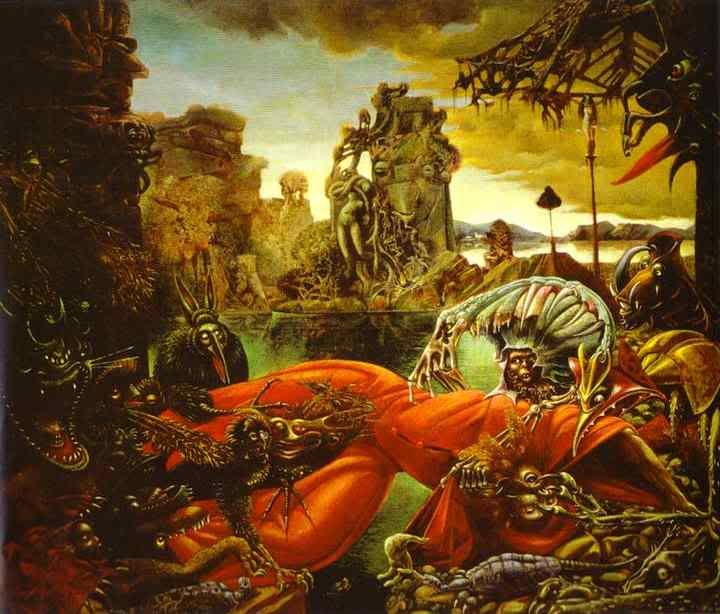
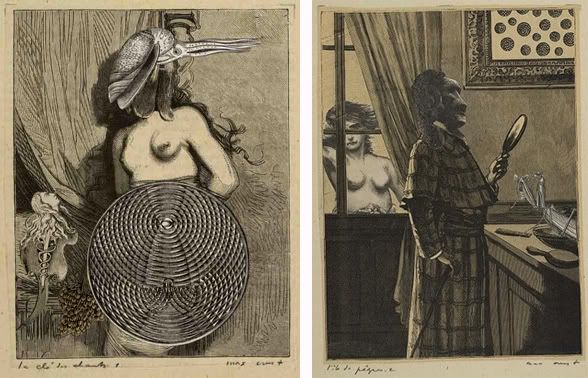
Of This Men Shall Know Nothing. Oil on canvas. 81 x 64 cm. 1923. Tate Gallery, London, UK.

The Equivocal Woman (also known as The Teetering Woman). 1923. Oil on canvas. 1923. 130.5 x 97. 5 cm. Kunstsammlung Nordrhein-Westfalen, Düsseldorf, Germany.

L'Ange du foyer ou Le Triomphe du surréalisme. 1937. Oil on canvas. 114 x 146 cm. painted in response to the defeat of the Republican Spain reflecting Max's feeling of helplessness in the face of the coming menace of fascism.

The Temptation of St. Anthony. 1945. Oil on canvas. 108 x 128 cm. Wilhelm-Lehmbruck-Museum, Duisburg, Germany.


"My wanderings, my anxieties, my impatience, doubts, beliefs,hallucinations; my loves, rages, revolts, contradictions; my refusals to submit to discipline, even my own; the sporadic visits of perturbation, my sister, the hundred headed woman - all this was not conducive to a favorable climate for quiet, serene work. Like my behavior my work is not classically harmonious, nor even classically revolutionary. Seditious, uneven, mcontradictiory, it isn't appreciated by the specialists of fine arts, culture, behavior, logic, morals. But it delights my accomplices: poets, pataphysicians, and some illiterates." M. Ernst (Peter Shamoni, MAX ERNST Maximiliana, p. 39)
You can find out more about him in Werner Spies: MAX ERNST: Life and Work and Max Ernst and Alchemy : A Magician in Search of Myth
You can find out more about him in Werner Spies: MAX ERNST: Life and Work and Max Ernst and Alchemy : A Magician in Search of Myth
0 comments:
Post a Comment